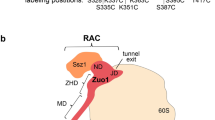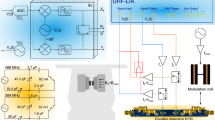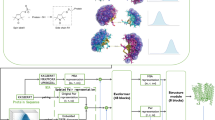Abstract
We describe a protocol for detecting electron spin–spin interactions between a radical and a metal ion in a protein or protein complex by saturation-recovery electron paramagnetic resonance (EPR). This protocol can be used with a protein containing an endogenous metal center and either an endogenous or synthetic radical species. We suggest a two-step approach whereby dipole–dipole or exchange interactions are first detected by continuous-wave EPR experiments and then quantified by saturation-recovery EPR. The latter measurements make it possible to measure long distances to within a few Ångstroms. The protocol for making distance measurements by saturation-recovery EPR will take approximately 6 days to complete.
This is a preview of subscription content, access via your institution
Access options
Subscribe to this journal
Receive 12 print issues and online access
$259.00 per year
only $21.58 per issue
Buy this article
- Purchase on SpringerLink
- Instant access to full article PDF
Prices may be subject to local taxes which are calculated during checkout








Similar content being viewed by others
References
Lakshmi, K. & Brudvig, G. Pulsed electron paramagnetic resonance methods for macromolecular structure determination. Curr. Opin. Struct. Biol. 11, 523–531 (2003).
Berliner L.J., Eaton G.R., & Eaton S.S. (eds.) Distance Measurements in Biological Systems by EPR (Kluwer Academic/Plenum Publishers, New York, 2000).
Hirsh, D.J., Beck, W.F., Innes, J.B. & Brudvig, G.W. Using saturation-recovery EPR to measure distances in proteins: applications to photosystem II. Biochemistry 31, 532–541 (1992).
Hirsh, D.J., Beck, W.F., Lynch, J.B., Que, L., Jr . & Brudvig, G.W. Using saturation-recovery EPR to measure exchange couplings in proteins: application to ribonucleotide reductase. J. Am. Chem. Soc. 114, 7475–7481 (1992).
MacArthur, R. et al. Component B binding to the soluble methane monooxygenase hydroxylase by saturation-recovery EPR spectroscopy of spin-labeled MMOB. J. Am. Chem. Soc. 124, 13392–13393 (2002).
Clegg, R.M. Fluorescence resonance energy transfer. in Fluorescence Imaging Spectroscopy and Microscopy Vol. 137 (eds. Wang, X.F. & Herman, B.) 179–251 (Wiley, New York, 1996).
Stryer, L. Fluorescence energy transfer as a spectroscopic ruler. Annu. Rev. Biochem. 47, 819–846 (1978).
Förster, T. Delocalized excitation and excitation transfer. in Modern Quantum Chemistry Vol. 3 (ed. Sinanoglu, O.) 93–137 (Academic Press Inc., New York, 1965).
Borbat, P.B. & Freed, J.H. Double-quantum ESR and distance measurements. in Distance Measurements in Biological Systems by EPR Vol. 19 (eds. Berliner, L.J., Eaton, G.R. & Eaton, S.S.) 383–456 (Kluwer Academic/Plenum Publishers, New York, 2000).
Raitsimring, A. “2 + 1” pulse sequence as applied for distance and spatial distribution measurements of paramagnetic centers. in Distance Measurements in Biological Systems by EPR Vol. 19 (eds. Berliner, L.J., Eaton, G.R. & Eaton, S.S.) 461–490 (Kluwer Academic/Plenum Publishers, New York, 2000).
Jeschke, G., Pannier, M. & Spiess, H.W. Distance measurements in biological systems by EPR. in Distance Measurements in Biological Systems by EPR Vol. 19 (eds. Berliner, L.J., Eaton, G.R. & Eaton, S.S.) 493–511 (Kluwer Academic/Plenum Publishers, New York, 2000).
Berliner L.J. (ed.) Spin Labeling 444 (Springer, New York, 2007).
Berliner L.J. (ed.) Spin Labeling II: Theory and Applications (Academic Press, New York, 1979).
Berliner L.J., (ed.) Spin Labelling 605 (Academic Press, New York, 1976).
Bloembergen, N. The interaction of nuclear spins in a crystalline lattice. Physica (The Hague) 15, 386–426 (1949).
Bloembergen, N., Purcell, E.M. & Pound, R.V. Relaxation effects in nuclear magnetic resonance absorption. Phys. Rev. 73, 679–712 (1948).
Bloembergen, N., Shapiro, S., Pershan, P.S. & Artman, J.O. Cross relaxation in spin systems. Phys. Rev. 114, 445–459 (1959).
Abragam, A. Overhauser effect in nonmetals. Phys. Rev. 98, 1729–35 (1955).
Kulikov, A.V. & Likhtenstein, G.I. Adv. Mol. Relax. Interact. Processes 10, 47–79 (1977).
Goodman, G. & Leigh, J.S. Jr. Distance between the visible copper and cytochrome a in bovine heart cytochrome oxidase. Biochemistry 24, 2310–2317 (1985).
Rakowsky, M., More, K., Kulikov, A., Eaton, G. & Eaton, S. Time-domain electron paramagnetic resonance as a probe of electron–electron spin–spin interaction in spin-labeled low-spin iron porphyrins. J. Am. Chem. Soc. 117, 2049–2057 (1995).
Eaton, G.R. & Eaton, S.S. Relaxation times of organic radicals and transition metal ions. in Distance Measurements in Biological Systems by EPR Vol. 19 (eds. Berliner, L.J., Eaton, G.R. & Eaton, S.S.) 29–154 (Kluwer Academic/Plenum Publishers, New York, 2000).
Debus, R.J., Feher, G. & Okamura, M.Y. Iron-depleted reaction centers from Rhodopseudomonas sphaeroides R-26.1: characterization and reconstitution with Fe2+, Mn2+, Co2+, Ni2+, Cu2+ and Zn2+. Biochemistry 25, 2276–2287 (1986).
Zhou, Y., Bowler, B., Lynch, K., Eaton, S. & Eaton, G. Interspin distances in spin-labeled metmyoglobin variants determined by saturation recovery EPR. Biophys. J. 79, 1039–1052 (2000).
Seiter, M., Budker, V., Du, J.-L., Eaton, G.R. & Eaton, S.S. Interspin distances determined by time domain EPR of spin-labeled high-spin methemoglobin. Inorg. Chim. Acta 273, 354–366 (1998).
Hirsh, D.J. & Brudvig, G.W. Long-range electron spin–spin interactions in the bacterial photosynthetic reaction center. J. Phys. Chem. 97, 13216–13222 (1993).
Portis, A.M. Electronic structure of F centers: saturation of the electron spin resonance. Phys. Rev. 91, 1071–1078 (1953).
Castner, T.G. Jr. Saturation of the paramagnetic resonance of a V center. Phys. Rev. 115, 1506–1515 (1959).
Galli, C., Innes, J., Hirsh, D. & Brudvig, G. Effects of dipole–dipole interactions on microwave progressive power saturation of radicals in proteins. J. Magn. Reson. B 110, 284–287 (1996).
Voss, J., Hubbell, W.L. & Kaback, H.R. Distance determination in proteins using designed metal ion binding sites and site-directed spin labeling: application to the lactose permease of Escherichia coli. Proc. Natl. Acad. Sci. USA 92, 12300–12303 (1995).
Roberts, J.D. ABCs of FT-NMR (University Science Books, Sausalito, CA, 2000).
Harris, R.K. Nuclear Magnetic Resonance Spectroscopy: A Physicochemical View (Wiley, New York, 1986).
Weil, J.A., Bolton, J.R. & Wertz, J.E. Electron Paramagnetic Resonance: Elementary Theory and Practical Applications 568 (Wiley, New York, 1994).
Symons, M.M.C. Chemical and Biochemical Aspects of Electron-Spin Resonance Spectroscopy 190 (John Wiley, New York, 1978).
Hyde, J.S., Swartz, H.M. & Antholine, W.E. in Spin Labeling II: Theory and Applications (ed. Berliner, L.J.) 71–113 (Academic Press, New York, 1979).
Hyde, J.S. Saturation recovery methodology. in Time-domain Electron Spin Resonance (eds. Kevan, L. & Schwartz, R.N.) 1–30 (Wiley, New York, 1979).
Yamauchi, T., Mino, H., Matsukawa, T., Kawamori, A. & Ono, T. Parallel polarization electron paramagnetic resonance studies of the S1-state manganese cluster in the photosynthetic oxygen-evolving system. Biochemistry 36, 7520–7526 (1997).
Bizzarri, A.R. & Cannistraro, S. Solvent modulation of the structural heterogeneity in FeIII myoglobin samples: a low temperature EPR investigation. Eur. Biophys. J. 22, 259–267 (1993).
Berthold, D.A., Babcock, G.T. & Yocum, C.F. A highly resolved, oxygen-evolving photosystem II preparation from spinach thylakoid membranes. FEBS Lett. 134, 231–234 (1981).
Pikal-Cleland, K.A., Rodriguez-Hornedo, N., Amidon, G.L. & Carpenter, J.F. Protein denaturation during freezing and thawing in phosphate buffer systems: monomeric and tetrameric beta-galactosidase. Arch. Biochem. Biophys. 384, 398–406 (2000).
Eaton, S.S. & Eaton, G.R. Irradiated fused-quartz standard sample for time-domain EPR. J. Magn. Reson. A 102, 354–356 (1993).
Sahlin, M. et al. Magnetic interaction between the tyrosyl free radical and the antiferromagnetically coupled iron center in ribonucleotide reductase. Biochemistry 26, 5541–5548 (1987).
Allen, J.P., Feher, G., Yeates, T.O., Komiya, H. & Rees, D.C. Structure of the reaction center from Rhodobacter sphaeroides R-26: protein–cofactor (quinones and Fe2+) interactions. Proc. Natl. Acad. Sci. USA 85, 8487–8491 (1988).
Ferreira, K.N., Iverson, T.M., Maghlaoui, K., Barber, J. & Iwata, S. Architecture of the photosynthetic oxygen-evolving center. Science 303, 1831–1838 (2004).
Loll, B., Kern, J., Saenger, W., Zouni, A. & Biesiadka, J. Towards complete cofactor arrangement in the 3.0 Å resolution structure of photosystem II. Nature (London, United Kingdom) 438, 1040–1044 (2005).
Hirsh, D.J. Using Saturation-recovery EPR to Measure Distances and Exchange Couplings in Proteins PhD thesis, Yale University (1993).
Du, J.-L., Eaton, G.R. & Eaton, S.S. Temperature, orientation, and solvent dependence of electron spin–lattice relaxation rates for nitroxyl radicals in glassy solvents and doped solids. J. Magn. Reson. A 115, 213–221 (1995).
Eaton, S.S. & Eaton, G.R. Determination of distances based on T1 and Tm effects. in Distance Measurements in Biological Systems by EPR Vol. 19 (eds. Berliner, L.J., Eaton, G.R. & Eaton, S.S.) 348–378 (Kluwer Academic/Plenum Publishers, New York, 2000).
Author information
Authors and Affiliations
Corresponding author
Ethics declarations
Competing interests
The authors declare no competing financial interests.
Supplementary information
Supplementary Fig. 1
Spectral diffusion in the inhomogeneously broadened EPR signal (PDF 80 kb)
Supplementary Discussion
Why saturation-recovery (and not inversion recovery)? (PDF 26 kb)
Rights and permissions
About this article
Cite this article
Hirsh, D., Brudvig, G. Measuring distances in proteins by saturation-recovery EPR. Nat Protoc 2, 1770–1781 (2007). https://doi.org/10.1038/nprot.2007.255
Published:
Issue date:
DOI: https://doi.org/10.1038/nprot.2007.255
This article is cited by
-
Enhancement of Paramagnetic Relaxation by Photoexcited Gold Nanorods
Scientific Reports (2016)
-
Effect of Lanthanide and Cobalt Ions on Electron Spin Relaxation of Tempone in Glassy Water:Glycerol at 20 to 200 K
Applied Magnetic Resonance (2016)
-
Measuring Cu2+-Nitroxide Distances Using Double Electron–Electron Resonance and Saturation Recovery
Applied Magnetic Resonance (2013)



